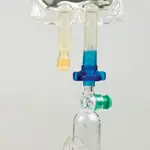Treatment for Lipophilic Toxicity
Kirsten E. Waratuke, DVM, ASPCA Animal Poison Control Center

Thomas, a 1-year-old neutered 35-lb standard schnauzer, was presented recumbent, vocalizing, and salivating heavily.
Clinical Signs
On presentation, Thomas was tachycardic (160 bpm) and hypothermic (97.0°F).
History
The owners, who were gone all day, came home to find Thomas recumbent and behaving abnormally. They found multiple piles of vomit and a chewed-up vial of baclofen (prescribed to one of the owners) that was missing 12 20-mg pills. The owners were unsure if any pills were in the vomitus.
Treatment
IV fluids (Plasmalyte, baxter.com) were administered at 25 mL/hr and blood was drawn for laboratory evaluation. Cyproheptadine, a serotonin antagonist, was administered at 1.1 mg/kg rectally to help with vocalization.1 The patient’s condition was rapidly deteriorating; his breathing slowed and he suffered a tonic–clonic seizure, which stopped with IV administration of diazapam at 15 mg. However, Thomas was hypoventilating at 8 breaths/min. Because respiratory arrest and hypercapnia are associated with severe baclofen exposure, the need for ventilator support was discussed with the owners, who were concerned about this treatment because of financial constraints.
Correct Answer
D. All of the above (increase IV fluids to a diuretic rate to help excretion of baclofen; continue symptomatic and supportive care; consider novel use of extralabel ile therapy).
Because of its low protein-binding and urinary excretion, baclofen’s excretion may be enhanced with IV fluid administration. Warming the patient; continuing anticonvulsant therapy (eg, diazepam); monitoring blood pressure, pulse oximetry, and end-tidal carbon dioxide; and instituting antiemetic therapy (to prevent secondary aspiration pneumonia) are important in treating baclofen toxicosis.
ILE Therapy
Another consideration is the novel use of ILE therapy, which has recently gained a foothold in human medicine for treatment of cardiovascular collapse secondary to local anesthetic toxicity. In addition, ILE is considered (and used) in human and veterinary medicine for toxicities involving other lipophilic substances. While extralabel and experimental, the use of ILE can be successful for severe, life-threatening toxicities involving lipophilic drugs (eg, baclofen).
ILE has been a component of total parenteral nutrition (TPN) and partial parenteral nutrition in human and veterinary medicine. It is composed of medium- and long-chain triglycerides derived primarily from soybean oil and stabilized in egg phospholipids, glycerol, and water. It is also the carrier in certain lipophilic drugs (eg, propofol). As ILE is isosmotic, it can be administered via a dedicated, sterile, peripheral line (as compared with TPN, which requires a central line). Intralipids (baxter.com) and Liposyn (hospira.com) are available in 10%, 20%, and 30% concentrations and packaged in 100-, 250-, 500-, and 1000-mL bags.

While the exact mechanism of action for ILE has yet to be determined, the lipid sink theory is currently most prevalent. With infusion of ILE, a lipid phase in the aqueous portion of the blood is created, acting as a sink for lipophilic drugs, preferentially pulling them out or keeping them out of the tissues. While the emulsion particles have a similar fate as chylomicrons, the fate of the substance in the lipid sink is unclear.

Complications
Potential complications from extralabel use include sepsis secondary to bacterial contamination and thrombophlebitis. In humans, lipemia, hepatosplenomegaly, jaundice, hemolysis, coagulopathy, fat emboli, and thrombocytopenia are potential concerns. Anecdotal reports of ILE adverse effects in veterinary medicine are hyperlipidemia, hemolysis, and pancreatitis.
Potential interactions between ILE and standard treatments are currently unknown; thus, traditional therapy should be the primary treatment modality.
ILE = intravenous lipid emulsion, TPN = total parenteral nutrition
Considering ILE Use
Human medicine has adopted a dose regimen for ILE use; this same dose has been extrapolated into veterinary medicine, in which ILE has been recommended to treat various toxicoses but should be limited to severe situations that are unresponsive to traditional therapy (see Current ILE Recommendations2). Toxicities from calcium channel blockers, psychotropic drugs, avermectin parasiticides, baclofen, and cholecalciferol are potential candidates for this novel, extralabel antidote. While these toxicants are all lipophilic, the degree of lipophilicity, mechanism of action, and kinetic properties differ.
Considering the lack of large-scale animal studies, determining appropriate ILE dosing in veterinary medicine is challenging.